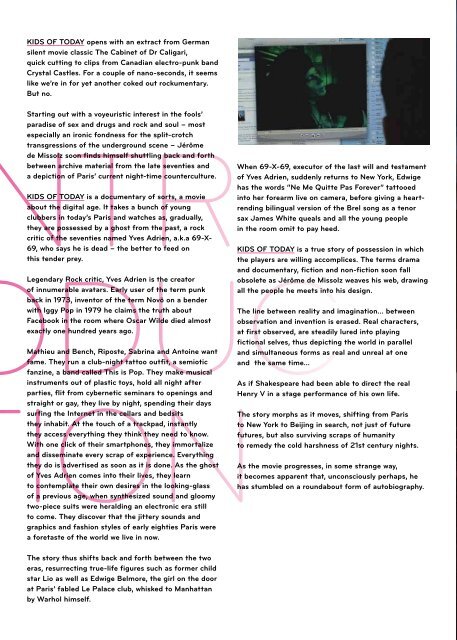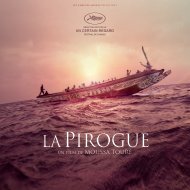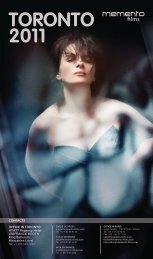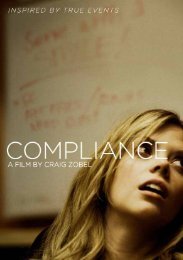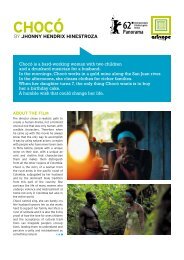BY JÃRÃME DE MISSOLZ - Memento Films International
BY JÃRÃME DE MISSOLZ - Memento Films International
BY JÃRÃME DE MISSOLZ - Memento Films International
You also want an ePaper? Increase the reach of your titles
YUMPU automatically turns print PDFs into web optimized ePapers that Google loves.
KIDS OF TODAY opens with an extract from German<br />
silent movie classic The Cabinet of Dr Caligari,<br />
quick cutting to clips from Canadian electro-punk band<br />
Crystal Castles. For a couple of nano-seconds, it seems<br />
like we’re in for yet another coked out rockumentary.<br />
But no.<br />
Starting out with a voyeuristic interest in the fools’<br />
paradise of sex and drugs and rock and soul – most<br />
especially an ironic fondness for the split-crotch<br />
transgressions of the underground scene – Jérôme<br />
de Missolz soon finds himself shuttling back and forth<br />
between archive material from the late seventies and<br />
a depiction of Paris’ current night-time counterculture.<br />
TR<br />
DUC<br />
ION<br />
KIDS OF TODAY is a documentary of sorts, a movie<br />
about the digital age. It takes a bunch of young<br />
clubbers in today’s Paris and watches as, gradually,<br />
they are possessed by a ghost from the past, a rock<br />
critic of the seventies named Yves Adrien, a.k.a 69-X-<br />
69, who says he is dead – the better to feed on<br />
this tender prey.<br />
Legendary Rock critic, Yves Adrien is the creator<br />
of innumerable avatars. Early user of the term punk<br />
back in 1973, inventor of the term Novö on a bender<br />
with Iggy Pop in 1979 he claims the truth about<br />
Facebook in the room where Oscar Wilde died almost<br />
exactly one hundred years ago.<br />
Mathieu and Bench, Riposte, Sabrina and Antoine want<br />
fame. They run a club-night tattoo outfit, a semiotic<br />
fanzine, a band called This is Pop. They make musical<br />
instruments out of plastic toys, hold all night after<br />
parties, flit from cybernetic seminars to openings and<br />
straight or gay, they live by night, spending their days<br />
surfing the Internet in the cellars and bedsits<br />
they inhabit. At the touch of a trackpad, instantly<br />
they access everything they think they need to know.<br />
With one click of their smartphones, they immortalize<br />
and disseminate every scrap of experience. Everything<br />
they do is advertised as soon as it is done. As the ghost<br />
of Yves Adrien comes into their lives, they learn<br />
to contemplate their own desires in the looking-glass<br />
of a previous age, when synthesized sound and gloomy<br />
two-piece suits were heralding an electronic era still<br />
to come. They discover that the jittery sounds and<br />
graphics and fashion styles of early eighties Paris were<br />
a foretaste of the world we live in now.<br />
When 69-X-69, executor of the last will and testament<br />
of Yves Adrien, suddenly returns to New York, Edwige<br />
has the words “Ne Me Quitte Pas Forever” tattooed<br />
into her forearm live on camera, before giving a heartrending<br />
bilingual version of the Brel song as a tenor<br />
sax James White queals and all the young people<br />
in the room omit to pay heed.<br />
KIDS OF TODAY is a true story of possession in which<br />
the players are willing accomplices. The terms drama<br />
and documentary, fiction and non-fiction soon fall<br />
obsolete as Jérôme de Missolz weaves his web, drawing<br />
all the people he meets into his design.<br />
The line between reality and imagination… between<br />
observation and invention is erased. Real characters,<br />
at first observed, are steadily lured into playing<br />
fictional selves, thus depicting the world in parallel<br />
and simultaneous forms as real and unreal at one<br />
and the same time…<br />
As if Shakespeare had been able to direct the real<br />
Henry V in a stage performance of his own life.<br />
The story morphs as it moves, shifting from Paris<br />
to New York to Beijing in search, not just of future<br />
futures, but also surviving scraps of humanity<br />
to remedy the cold harshness of 21st century nights.<br />
As the movie progresses, in some strange way,<br />
it becomes apparent that, unconsciously perhaps, he<br />
has stumbled on a roundabout form of autobiography.<br />
THIS IS<br />
THE<br />
BACK-<br />
GROUND<br />
April 2008. Paris Galerie du Jour unveils the exhibition<br />
Des Jeunes Gens Mödernes. Soon arises the idea to make a film<br />
based on the exhibition’s central topic. Love Streams agnès b.<br />
Productions propose the project to veteran music director,<br />
Jérôme de Missolz. Thus KIDS OF TODAY was born: a pop/art/<br />
style kaleidoscope of late seventies-early eighties Paris<br />
Niche interest you think. Well sure. Paris was always more about<br />
le look than la musique. Clubs like Le Palace, Le Privilege<br />
or Les Bains Douches were pale copies of New York’s Studio 54,<br />
commercial flashpoints in a wannabee local scene fuelled by<br />
rag-trade dollars, that capitalized on a blasé backlash against<br />
riots and revolutionary dreams to sell more fashion. The left-wing<br />
antics of May 1968, style-hounds claimed, had deprived French<br />
kids of the simple pleasures of music and sex and drugs that<br />
everyone else was enjoying. It was time to catch up, time to<br />
have fun.<br />
From the late seventies on, a decade-long festival of limp-wristed<br />
pose, glitter and glam, began, steeped in that special Paris thing,<br />
that blunts even the self-loathing of punk into camp. It was<br />
a right-wing, post-Gaullist movida that aped the futurism of<br />
Kraftwerk, plundered the angst of Joy Division, plagiarized the<br />
craftsmanship of Bowie, to counterfeit a counterculture in which<br />
only the cross-dressing, the catwalks and the coke were up<br />
to scratch.<br />
But to Jérôme de Missolz, all this meant something else.<br />
As a young man from a dead-end arms-manufacturing town three<br />
hundred miles south of Paris, the freedom and lack of moral<br />
constraint were what he aspired to. He hit the scene with<br />
a super-8 camera and went to work, shooting gay underground<br />
movies with cult hero Lionel Soucaze, an early Rita Mitsouko<br />
promo, bodybuilders taking Le Palace by storm, Edwige prancing<br />
down a catwalk in black rubber diving flippers and countless<br />
other musical and fashion-fetish climaxes.<br />
All this footage is cut into KIDS OF TODAY, making the movie<br />
not just an essay on how electronics changed the way people<br />
hope for the greater freedoms of night, but also a clandestine<br />
(if “noisy”) meditation on the passage of time, with a playlist<br />
to die for and an uncanny knack for generating spurts of emotion<br />
in motel suites and backrooms the world over.<br />
Because the story is told through the eyes of rock critic,<br />
who claims to be dead, it becomes a documentary fairy-tale<br />
of sorts, a vampire movie for the new underground.<br />
The characters travel from sound to sound, from night to night<br />
and across the globe, searching for humanity – in a world with<br />
almost none.<br />
In the end, it is as though this need for humanity triggers a selfknowledge<br />
in sadness and joy they never knew.<br />
To this day, Jérôme de Missolz leads a double life. The visible<br />
part is as a veteran music and arts documentary director, working<br />
for all the major channels. The other is his life in experimental<br />
film, shooting stop-frame, mixed media, transgression and pose,<br />
turning up the volume till the body starts to spin and the mind<br />
starts to go. For the first time, with this project, he brings the two<br />
parts of himself into fusion. The result is a complex magic<br />
that steals up unawares, making you laugh and think and cry<br />
in no particular order. And by the time he is through you know<br />
nothing quite like this combination of private and public,<br />
of loud and quiet, of thoughtful and vain and true has ever<br />
been seen before.<br />
The story thus shifts back and forth between the two<br />
eras, resurrecting true-life figures such as former child<br />
star Lio as well as Edwige Belmore, the girl on the door<br />
at Paris’ fabled Le Palace club, whisked to Manhattan<br />
by Warhol himself.


